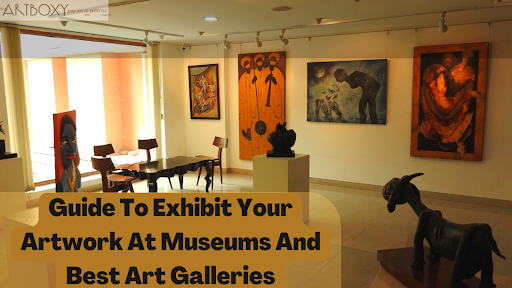Museums are the epitome of art representation. Established and seasoned artists, as well as upcoming artists, all aspire to present their art at the best art galleries and museums. However, getting your art approved and presented in a museum is a challenging endeavor.
Countless art collectors, enthusiasts, and the general public visit museums to see artworks created by recognized and new artists.
To present your art in a museum, you are not just competing with the current artists but art creators from different periods and eras.
Everybody artists aspire to sell art prints online through renowned museums owing to the enhanced visibility and reputation associated with it.
However, museum representations are highly competitive since they have limited space, and even the works of commercially successful artists might not get approved for museum exhibitions.
So how do you make your way to museum exhibitions to propel your art career forward?
Initially, when I tried to sell my paintings online through museums or art galleries, it was a daunting task. But you don’t need to go through the same struggles.
We have prepared a comprehensive guide to help you through the entire proposal and selection process.
Guide To Exhibit Your Artwork At Museums And Best Art Galleries
Select A Suitable Museum
There might be various museums accepting different forms of artwork. Determine your niche. Make a list of the museums that venture into artworks related to your core art creation style and theme.
Note the history and the mission of each museum and the best art galleries you have shortlisted. During a proposal submission, the museum or art gallery will evaluate your passion for the museum’s core values and mission.
Get information about the museum’s or art gallery’s current and future schedules, types of exhibitions hosted, and their primary themes.
While preparing a proposal for museum submission or uploading your artwork, attend an online art platform and ask yourself the following questions to get an idea about the audience persona.
- What is the annual footfall of the music or art gallery?
- What are the visitor demographics?
- What are the artistic inclinations of the audiences and art collectors?
- What are the peak attendance periods?
- What is the attendance volume of each show or exhibition?
Wondering, “What is the easiest way to sell my paintings online?” Create your profile at an online art platform in collaboration or partnership with renowned art galleries, museums, and exhibitions, worldwide.
Prepare Proposal
Your proposal should always be detailed, free of errors, and easy to comprehend. Ensure to upload the following:
- High-quality digital image of your artwork. Ensure that your artwork is captured in the correct lighting to avoid drastic color changes or shadow formation.
- Your resume or CV highlights only achievements, education, and training.
- A brief artist biography
- A short, crisp description of your artwork
- Artist statement
- Links to your social media channels (optional).
Your artist biography should include details about your art education and professional background.
Your artwork description should include the following points:
- What is the theme inspiration and meaning you want to convey through your artwork?
- How did you create it?
- Why do you want the audiences to see and appreciate them?
Upload Proposal
When you perform diligent research and collect relevant information, your submission process becomes relatively easy.
Read the submission instructions carefully before uploading your artwork for evaluation.
The best art galleries maintain superior quality and therefore strictly adhere to their submission guidelines. Missing even a minor step might lead to rejection.
Receive Response
In most cases, online galleries and museums are swamped with submissions from across the world.
It may take a considerable time for the art curators to carefully evaluate your artwork and share a response. Be patient. In case you don’t receive any communications, you can share a follow-up mail or leave a message to enquire about the artwork submission status.
Once your artwork gets approved, you are ready to present art to a global audience. Some online platforms allow artists to choose the venue and date of the exhibition with their partner galleries.
Many museums and exhibitions display your artwork digitally. This prevents unnecessary transportation and preservation costs. Once you sell art prints online, you can directly ship the artwork to the purchaser’s address.
Also read: How To Create an Art Blog to Sell Sculptures Online
Use Social Media And Other Art Communities To Promote The Art Exhibition
Facebook, Instagram, Pinterest, and Tumblr are becoming increasingly popular social media platforms.
In fact, almost billions of online traffic have active social media accounts. As an artist, you can leverage the power of social media to promote your exhibitions and artworks. You can also prepare a mailing list and share personal invitations through newsletters.
You can also execute subtle marketing campaigns for your artworks through informational posts. Some artists even maintain a block section to share detailed informational content about their artwork, their working styles, tools and techniques, and much more.
This additional marketing technique doesn’t just help you sell art prints online but also establishes a brand name for yourself.
Benefits of exhibiting your artwork with museums and art galleries online
- Easy to preserve and maintain the art.
- No transportation complications or cost.
- Easy and simple process to upload
- Feasibility to connect with similar artists from the comfort of your home or studio.
- Expand your professional network.
- Get professional insights and guidance with a premium membership.
- Get high-quality images of your digital displays for use in your portfolio.
- Reach out to a global audience.
- Avoid exorbitantly high commissions. Most online galleries and museums have affordable membership options.
- Get your art represented by trained professional curators.
Conclusion
The art realm is huge, and the competition is fierce. Therefore to make your mark in the industry, you need to be proactive, omnipresent and execute unique marketing campaigns. Additionally, the proposal management process is highly competitive and time-consuming.
Thankfully online platforms have made the journey easier for upcoming and new artists. Renowned online art platforms generally have collaborations and partnerships with art gallery exhibitions and fairs where upcoming artists can represent their artwork to a wide variety of audiences. Sign up with an online art platform and start your artistic endeavor today.






























